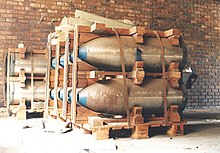A Brief History
On May 18, 1974, India’s Operation Smiling Buddha resulted in the successful detonation of a nuclear weapon, becoming the sixth nation to explode a nuclear device. Prior to India, only the 5 permanent members of the UN Security Council (US, Soviet Union/Russia, United Kingdom, France and China) had developed nuclear weapons, at least officially.
Digging Deeper
India officially claimed a yield of about 13 kilotons, similar in size to the bomb the US dropped on Hiroshima, Japan in 1945. Outside scientists estimated the explosion as less powerful, perhaps as little as 2 kilotons. Canada, which had supplied the nuclear reactor to India and the United States, which had supplied the heavy water, were taken aback by the development of a nuclear warhead and condemned the action. Pakistan, India’s close ethnic relatives differing in religion (India predominantly Hindu, Pakistan predominantly Muslim) reacted by resolving to develop their own nuclear arsenal to counter the expected stockpile of Indian nuclear warheads.

India is now believed to have 110 to 120 nuclear warheads, and rival Pakistan now has a similar number, having finally developed their own nuclear warheads in 1998. North Korea has been in the news in the past couple years, having finally successfully detonated their own nuclear device in 2006, with as many as 15 warheads believed to be in their possession. Each of the countries named in this article as being nuclear armed are openly admitting of owning such weapons, while Israel is believed to possess nuclear weapons as well but does not publicly admit to such possession. Israel is variously estimated to have between 60 and 400 such warheads. To this day, the United States is the only country to have ever used nuclear weapons against another country, dropping 2 such weapons on Japan in 1945. In 1981, Israel bombed an Iraqi nuclear power plant to stifle Iraqi attempts to build nuclear weapons.
The Republic of South Africa, possibly with the assistance of Israel, developed and possessed 6 nuclear warheads in the 1980’s, but dismantled those devices in the 1990’s, becoming the only known country to voluntarily disarm nuclear status.

Former Soviet Republics that had nuclear weapons based on their territory ceded those weapons to Russia upon the break up of the Soviet Union. The United States stores and makes available nuclear weapons for the following NATO allies: Belgium, Germany, Italy, the Netherlands, and Turkey.
The United States with a 6600 warhead arsenal and Russia with 6800 nuclear warheads easily surpass the rest of the world’s nuclear weapons combined, with France having the third most warheads with only 300. Even China, nuclear armed since 1964, has only perhaps 270 nuclear warheads.

The next country most likely to develop nuclear weapons is Iran, currently under an international agreement to abstain from nuclear weapon development, although US President Donald Trump in May of 2018 has announced that the United States now considers that treaty to be invalid. Question for students (and subscribers): Does this development mean Iran will now quickly work to develop those weapons? Does it mean the U.S. or Israel will preemptively bomb Iran to prevent manufacture of such weapons? The stakes are high and the outcome is unknown for now. We will have to wait and see what develops. Feel free to give us your opinion on the state of nuclear weapons in the world and what you think may happen with the North Korean and Iranian nuclear programs in the comments section below this article.

If you liked this article and would like to receive notification of new articles, please feel welcome to subscribe to History and Headlines by liking us on Facebook and becoming one of our patrons!
Your readership is much appreciated!
Historical Evidence
For more information, please see…
Baker, David. Nuclear Weapons: 1945 Onwards (Strategic and Tactical Delivery Systems). Haynes Publishing, 2017.
Braut-Hegghammer, Malfrid. Unclear Physics: Why Iraq and Libya Failed to Build Nuclear Weapons. Cornell University Press, 2016.
Kanwal, G. Sharpening the Arsenal: India’s Evolving Nuclear Deterrence Policy. HarperCollins, 2018.
The featured image in this article, a map of worldwide nuclear testing totals, 1945-1998, has been released into the public domain worldwide by its author, Fastfission.
You can also watch a video version of this article on YouTube.


